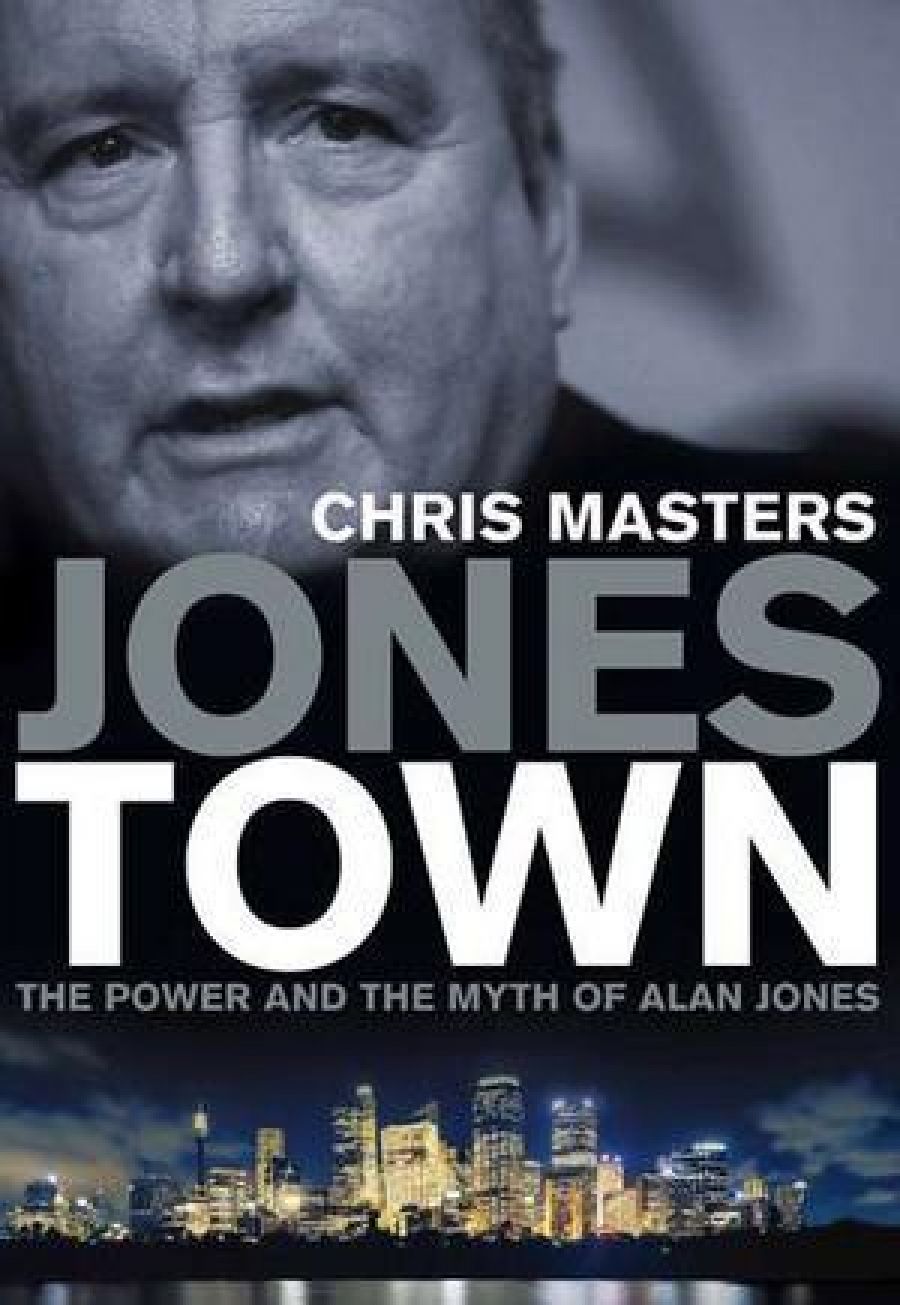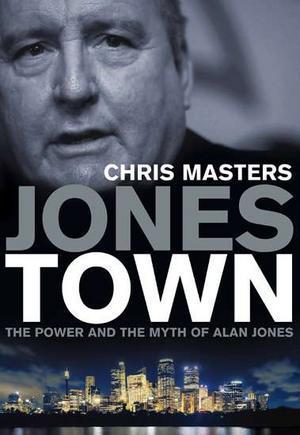
- Free Article: No
- Contents Category: Biography
- Custom Article Title: Last man standing
- Review Article: Yes
- Article Title: Last man standing
- Online Only: No
- Custom Highlight Text:
This is, of course, a much-awaited biography. Its subject, the commercial broadcaster Alan Jones, has long been a contentious figure. While some believe his influence over his audience has actually determined the outcomes of certain state and federal elections, others believe that this influence is a self-perpetuated myth that Sydney-siders should repudiate. Chris Masters, the author, is something of a local icon; one of the most respected and fearless of Australian television journalists, whose professional integrity is widely acknowledged.
- Book 1 Title: Jonestown
- Book 1 Subtitle: The power and the myth of Alan Jones
- Book 1 Biblio: Allen & Unwin, $49.95 hb, 527 pp, 174175156X
- Book 1 Cover Small (400 x 600):

- Book 1 Cover (800 x 1200):

In some ways, Jonestown is not a biography at all. Rather, it is a diagnosis of two pathological conditions: the psychological conditions which have produced the particular persona and mode of performance that Jones has developed; and the political conditions which have allowed the perceptions of his importance to flourish.
In relation to the first of these pathologies, Masters suggests that Jones suffers from what the Diagnostic and Statistical Manual of Mental Disorders describes as ‘narcissistic personality disorder’. In support of this diagnosis, Masters quotes from the manual and lists the symptoms associated with this condition. His account of Jones’s early adulthood and the trajectory of his teaching career generates a great deal of evidence of the behaviours on this list. Emerging from the account is a picture of a young man with great talents – a charismatic and gifted person who used his ‘magic’ (as Masters calls it) to gain power over others. What Jones lacks, according to this account, is a sense of proportion, a brake on his behaviour that would enable him to pursue his own objectives without alarming those above him or bruising those subordinate to him. Jones’s oratorical skills and his ability to focus those in his charge on a shared objective figure large here, and they are clearly recognised and effective capacities. Repeatedly, Masters suggests, what brings Jones undone is his ruthlessness in first bending others to his needs, then punishing them with his contempt when they are no longer needed or, worse still, when they try to free themselves from his influence.
Despite Masters’s principled attempts to be fair and to endow the story with its own sense of proportion, Jones is not an attractive figure. Jonestown, though, is a pretty riveting read. Tracing the sources of a personality whose public persona we know all too well is an interesting task, and Masters drives the narrative briskly. It needs to be admitted, though, that it is complicated by the fact that a central plank in the diagnosis is Jones’s sexuality. Masters sees the repression of Jones’s sexuality, and the potential for shame and humiliation it seems to hold for him, as motivating much of the story told in the book. As he puts it, ‘the masking of his apparent homosexuality is a defining feature of the Jones persona’. Masters suggests that it is implicated in Jones’s lifelong investment in rugby, in his personal habit of mentoring and supporting young men, in his excessive need for admiration and deference, and in the difficulties he has had in empathising with others. For Masters, ‘Jones’ apparent self-belief that he is, on the one hand, damaged and, on the other hand, special goes a long way to explaining an unusual personality’. Masters is careful to stipulate that at no point is he accusing Jones of behaviour that is sexually exploitative or predatory; indeed, Masters implies that Jones seems to deal with his sexuality as a private psychological condition rather than as something which has a social dimension.
There is every reason, then, for Masters to claim that he could not have written the book without dealing with the issue. That said, one can understand why Jones’s supporters may still feel aggrieved. Although Masters is very careful, most of the time, to avoid taking cheap shots or indulging in juicy innuendo, there are moments in the book where one is made slightly uncomfortable by his approach. At times, it seems that, despite the best of intentions, Masters’s concern about Jones’s toxic influence on the political climate of Sydney is allowed to spill over into the more personal details.
This brings us to the second, and in the long run the far more important, pathology – the set of political conditions which have enabled Jones’s rise to power. This seems to me the core of Masters’s project. He is interested in examining the precise nature of the power Jones wields, particularly in state politics. He is curious about how Jones can so successfully represent himself as the spokesperson for ‘Struggle Street’ – not only to the politicians but to the residents of ‘Struggle Street’ themselves. Most importantly, Masters is morally offended by the corruption of the democratic process which can cede so much influence to such an individual, as well as by the gullibility of the Sydney audience which seems happy to applaud this practice, as if it is in some way preferable to the democratic process. There is nothing dispassionate about this second half of the book, which is focused on Alan Jones, the media demagogue.
While one might quibble about the depth of the evidence gathered for the first half of the book – there is very little about Jones’s childhood, for instance, and some of the school teaching material depends on many sources who preferred not to be named – one could not do that about the second half. For a start, much of it is on the public record through proceedings such as the ‘cash for comment’ hearings. There are also a number of informants who can have nothing further to fear from Jones; to people such as former NSW Police Commissioner Peter Ryan, Jones has already done his worst. What emerges is a detailed account of what amounts to the corruption of democratic process in New South Wales state politics.
One of the things that I have learnt from my own academic research into talk-back radio is how different Jones is from virtually all of his counterparts working in the format. John Laws can justifiably claim to be working as an entertainer, and Neil Mitchell performs an essentially journalistic role in producing a form of current affairs. Like Jones, they will routinely deal with politics as a significant (but not always the primary) topic, but, largely, their ambitions end with the production of a successful programme. Jones’s ambitions are different. It is clear from even a cursory analysis of his programme that he sets out to directly influence the politics upon which he comments, and that seems to be his primary objective. That he clearly succeeds from time to time, and that he has been able to bully federal and state politicians into placating him, must encourage him to pursue this objective with even greater vigour.
Masters deals with this at some length and in a number of contexts. He provides us with analyses of the relationships Jones brokered with prominent politicians such as Labor’s Bob Carr and Morris Iemma, or the Liberals’ Kerry Chikarovski and Peter Collins. He details how much time Jones spends harassing politicians by letter and telephone in support of a wide variety of causes: he tells us, for instance, that in 1999 Alan Jones sent 7578 letters! While many of these are indeed for good causes, which reflect well on Jones, some are not. The book is littered with examples of Jones’s attacks on individuals – in some cases, hapless bureaucrats who have been foolish enough to disagree with Jones or to frustrate him in some way. In certain instances, those who have been named by Jones have sought redress through the courts; Masters quotes a number of cases where Jones’s employer has seen fit to offer an out-of-court settlement, itself an indication of how likely they felt a successful defence might have been. Others who have run foul of Jones have had their careers ended; again, Masters cites numerous cases where the targeting of particular functionaries or advisers has resulted in their being sacked or moved on. Finally, Masters provides instances where Jones’s intervention, as effective as it has been ill-informed, has carried dire consequences for the wellbeing of the state. In a devastating chapter entitled ‘The Emperor’s New Clothes’, Masters presents numerous cases where Jones, wrong-headed but indefatigable, pushed harmful agendas in public, allegedly defaming senior police and public servants along the way.
The most egregious example is the campaign led by Jones, enlisting former policeman Tim Priest and academic Richard Basham, which Masters says effectively killed off police reform in New South Wales. The chapter reveals how a legacy of acceding to Jones’s influence in the past had rendered the New South Wales government almost incapable of resisting him. At the end, with the police commissioner run out of town, public servants sacked or moved on, and the anti-corruption agendas driving police reform thoroughly undermined, Jones is the last man standing. Masters ruefully concludes, ‘in New South Wales, you might well wonder which is the real government and which is the real opposition’.
All of this is made much worse, of course, by the possibility that the campaigns Jones mounts are the result of commercial transactions. Masters’s account of the ‘cash for comment’ inquiry takes what is by now almost the common-sense view that the case against Jones was proven. Notwithstanding Jones’s denials and his highly implausible explanations at the time, Masters tells us that most people seem to believe Jones’s opinions can be bought. That consideration takes the question of Jones’s political influence into the territory of political corruption.
There is little evidence that any such concerns matter much to Jones’s audience. His ratings suffered little from ‘cash for comment’, and he continues to lead the breakfast radio market in Sydney. One can sense Masters’s frustration as he addresses the current situation in his final chapter, ‘The Misinformation Revolution’. Perhaps it is ‘inescapable’, he says, that Jones ‘brings out both the bully in the media and the coward in Sydney’. However, as Masters brings the book to its conclusion, he issues a challenge to Sydney-siders to resist the condition he has diagnosed. His personal objective in writing the book, he says, was ‘not to do a Jones on Jones and drive him out of town, but rather, to urge the town to stand up to him’. It would be hard to finish this book without feeling that such a response is well overdue.


Comments powered by CComment